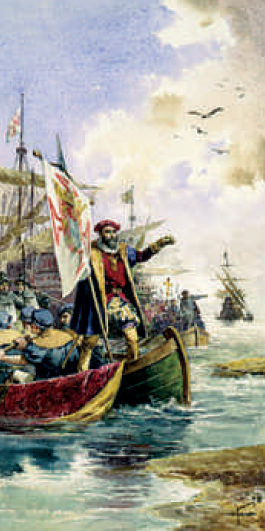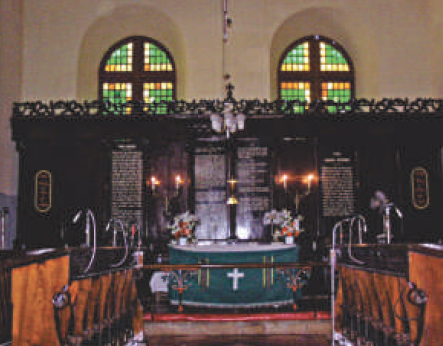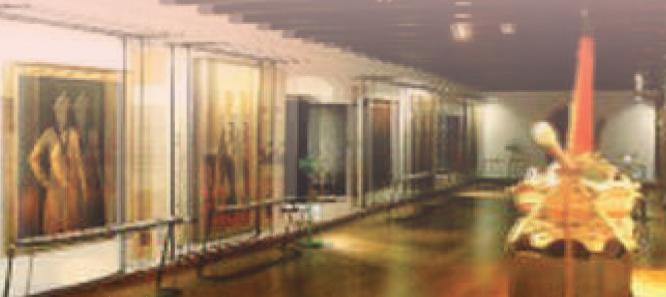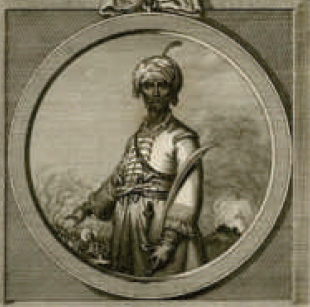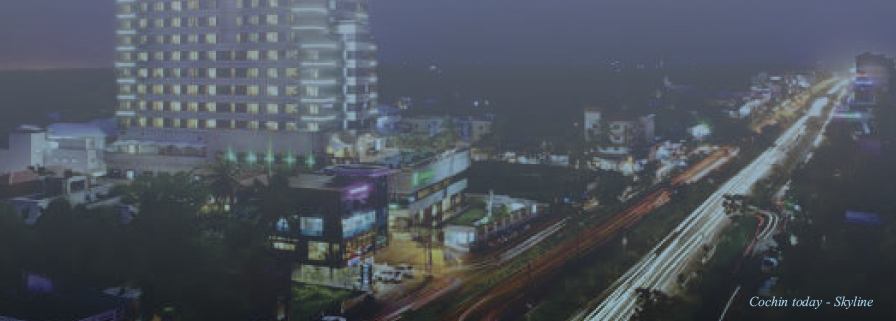Cochin – The Dutch, Portuguese and Jewish Influences
(→Cochin – The Dutch Portuguese and Jewish Influences) |
|||
| Line 17: | Line 17: | ||
By Dr. Vinita Kaul Gardner | By Dr. Vinita Kaul Gardner | ||
| + | |||
| + | '' India Harmony '' Volume - 1 : Issue - 2, 2013 | ||
[[File: Arrival of the Portugese.png|Arrival of the Portugese|frame|500px]] | [[File: Arrival of the Portugese.png|Arrival of the Portugese|frame|500px]] | ||
Revision as of 18:27, 11 January 2014
This is a collection of articles archived for the excellence of their content. Readers will be able to edit existing articles and post new articles directly |
Cochin – The Dutch Portuguese and Jewish Influences
By Dr. Vinita Kaul Gardner
India Harmony Volume - 1 : Issue - 2, 2013
Cochin, or Kochi, grafted upon the picturesque map of “God's Own Country” or Kerala with a pristine beauty, defying definition, rightfully earning for it the exotic sobriquet of “Queen of The Arabian Sea” with its potpourri of Portuguese, Dutch and Jewish influences impacting indelibly upon the fading silhouettes of history...will always remain somewhat of an enigma! Viewed through the mists of time...of chance wayfarers...of dashing adventurers and foreign navigators who steered the fortunes of this quixotic place towards a dreamlike destiny...
Even as the gossamer-like Chinese Fishing Nets are silhouetted delicately against an unblemished azure sky, or the Mattanchery Palace exudes a definitive Dutch influence or the Jewish Synagogue stands stoic against the onslaught of other faiths....there arises in the mind a dichotomy...of what destiny decreed and of what finally came to pass in this charming city, with its cultural cameos of a distant past...
The city of Cochin, which is a major port city on the west coast of India by the serene waters of the Arabian Sea, was an important spice trading centre on the Arabian Sea coast from the 14th century. Occupied by the Portuguese Empire in 1503, it was the first of the European colonies in India. It remained the main seat of Portuguese India until 1530, when Goa was chosen instead. The city was later occupied by the Dutch and the British, with the Kingdom of Cochin becoming a princely state.
In a voyage of discovery, let us travel down the labyrinthine alleys of Time or sail over the uncharted waters of erstwhile unexplored seas, to trace the fascinating but chequered history of this land which God decreed be bestowed with such verdant beauty….
Cochin, which lies 220 kms north of
Thiruvananthapuram, the state capital of Kerala,
figured prominently in the writings of ancient
travellers and tradesmen. Alluding to it variously
as Cocym, Cochym, Cochin, and Kochi, these
quaint appellations only added spice to its innate
charm!
The Cochin Jewish community called Cochin as Kogin which is seen in the seal of the synagogue, still owned by the community! The origin of the name "Kochi" is thought to be from the Malayalam word kochu azhi, meaning 'small lagoon'. Accounts by Italian explorers Nicolo Conti (15th century), and Fra Paoline in the 17th century, however, maintain that it was called Kochchi, named after the river connecting the backwaters to the sea! After the arrival of the Portuguese, and later the British, the name Cochin stuck as the official appellation. Until 1996, when the city reverted to a closer anglicisation of its original Malayalam name, Kochi, by which it is officially known today.
Known to the Yavanas (Greeks and Romans) as well as the Jews, Arabs, and Chinese since ancient times, Kochi rose to significance as a trading centre after the port around Kodungallur (Cranganore) was destroyed by massive flooding of Periyar in 1341A.D. and remained the fulcrum of the exotic Indian spice trade for many centuries! The earliest documented references to Kochi occur in books written by Chinese voyager Ma Huan during his visit to Kochi in the 15th century as part of Admiral Zheng He's treasure fleet! Perhaps the unique Chinese Fishing Nets, used till date to catch shoals of squirming fish, are Zheng's lasting, if somewhat nebulous legacy, framed against carmine sunset skies, when the sun set on another dynasty long ago!
It is believed that the Portuguese navigator, Pedro Álvares Cabral ,founded the first European settlement in India at Kochi in 1500 A.D From 1503 A.D.to 1663 A.D., Fort Kochi was ruled by Portugal. When we set tentative foot in this erstwhile Portuguese stronghold – a region in the city of Kochi in the state of Kerala, a feast of treasures assaulted our anticipatory minds and eager gaze!
Fort Kochi is part of a handful of water bound regions toward the south-west of mainland Kochi – and collectively known as Old Kochi or West Kochi; along with adjacent Mattancherry, in 1967 these three municipalities, with a few adjoining areas, were amalgamated to form the Corporation of Cochin.
Perhaps it would be appropriate to commence “the pilgrim's progress” at Saint Francis Church - originally built by Portuguese Franciscan friars in 1503. Believed to be the oldest existing European church in India, it provided sanctuary for the mortal remains of the Portuguese explorer, Vasco da Gama, for 14 years after his death in 1524, until his remains were transferred to Lisbon.
Lovingly built of wood originally, this fascinating church, which was Roman Catholic during the Portuguese period from 1503 to 1663, Dutch Reform from 1664 to 1804, and Anglican from 1804 to 1947, was later reconstructed in stone in the mid-sixteenth century.
As one exited from its sacred interiors, out into the mellow winter sunshine, one paused….listening….and surely it was the unmistakable echoes of the marching of boots that one heard…..preserved in the cosmic wheel of time…..and relayed to us mere mortals here on earth! For this Parade Ground, covering more than four acres, was used by the Portuguese, the Dutch, and the British for conducting military drills and parades during the colonial years, their Defence establishments housed in some of the elegant buildings surrounding the ground – today a recreation and sporting turf echoing to modern youth's boisterous camaraderie!
Determined to savor multicultural flavors simultaneously- and savor two of Kochi's major morsels of the cultural feast – we went across to adjacent Mattancherry – home to the oldest Synagogue in the Commonwealth – the Jewish or Paradesi Synagogue, built in 1568, and the Dutch or Mattancherry Palace.
As you traverse the quaint cobbled streets of Jew Town, a fascinating potpourri of stores selling antique ware, a thriving spice trade and a pepper exchange lending much color and noise to this congested street, hemmed in on both sides with the remaining houses of the handful of existing Jews, you come to the charming Synagogue itself.
An esoteric reminder of another time, another place, we walked –wonderstruck – with our admiring gaze riveted to the fascinating floor of the Synagogue!! Not in deference to some strange Jewish custom but because of the exquisite, handpainted, willow-pattern tiles of this ancient hall of worship! “No two tiles are alike” explained the genial, ageing guardian of this unique holy abode, to us somewhat loftily! Lovingly transported here by Ezekial Rahabi in the 18th century all the way from Canton, China, where he had trading interests, these delicate tiles are mesmerizing in their beauty…..
As we wandered in hushed wonder through the Synagogue's precincts, we solemnly observed the Great Scrolls of the Old Testament, two copper plates copiously inscribed with details of privileges granted to the Jews during the reign of Bhaskara Ravi Varman in the 10th century, glorious gold Torah crowns set with gems, the synagogue's elaborate lighting with Belgian crystal chandeliers illuminating the Torah! The holy book of the Jews, the Torah, its fragile pages made from paper processed from goatskin, are inscribed in Hebrew.
Mattancherry Palace If you have a penchant for collecting authentic memorabilia, visit the home of Sarah Cohen, who at 90 years of age in 2012, sat bent stoically in a traditional kippa and pale yellow dress, determinedly embroidering Jewish motifs on caps!
In case you are a Jew and time it right, you can participate in the richly evocative Hanukkah Celebrations in: Koder House in Fort Kochi, which belonged to Satu Koder and his wife Gladys, and is a boutique hotel today. The Hanukkah is celebrated here every year when the community, Kochi residents and visitors, congregate to participate in the festivities.
The Jewish quarters of Mattancherry or Jew Town, once flourished with trade, Hebrew culture and prayer. Once the centre of the White Jews or Cochin Jews, who are said to have settled here after fleeing persecution, speak fluent Malayalam and observe their customs and rituals diligently, today there are only nine surviving members of the community! Since ten is the minimum required quorum for prayer service at the synagogue, they have to summon the services of a rabbi all the way from Israel!
Time was not at a premium for us, so we listened spellbound as they animatedly recounted tales of bygone times when there were large community weddings, when Hanukkah, Passover, Yom Kippur, and Jewish New Year were all observed in full regalia, when the women dressed in their traditional finery and made traditional food, and when they could buy kosher meat from a Jewish butcher!
The Portuguese rule was followed by that of the Dutch, who had allied with the Zamorin of Calicut to conquer Kochi. By 1773, the Mysore ruler Hyder Ali extended his conquest in the Malabar region to Kochi forcing it to become a tributary of Mysore. The hereditary Prime Ministership of Kochi held by the Paliath Achans ended during this period.
Perhaps it would be appropriate to reconnoitre the Mattancherry or Dutch Palace, as it is now known, at the point of transition from Portuguese to Dutch supremacy, as it bore the imprint of both architectural techniques! The Palace, originally built by the Portuguese and presented to the Cochin Raja Veera Kerala Varma in 1555, acquired its present name after 1663 A.D. when the Dutch carried out some extensive repairs. It is believed that the Cochin rajas held their coronation ceremonies in the Central Hall of this doublestorey quadrangular building. Rooms adjacent to this contain breathtaking 17th-century murals depicting scenes from the Puranas and the great epics - the Ramayana and the Mahabharata.
Back in Fort Kochi are other reminders of the Dutch presence in India. The Dutch Cemetery, consecrated in 1724, stands as eloquent testimony of the many men and women from Europe who came down all the way to play out their roles in the colonial 17th, 18th and 19th centuries.
Or the impressive VOC Gate for that matter! Facing the famous Parade Ground is this large wooden gate with the initials 'VOC' carved onto it, representing the monogram of the once mighty Dutch East India Company. The inscription also indicates that it was built in the year 1740.
Meanwhile, the Dutch, fearing an outbreak of war on the United Provinces, signed the Anglo-Dutch Treaty of 1814 with the United Kingdom, under which Kochi was ceded to the United Kingdom in exchange for the island of Bangka. However, there are evidences of English habitation in the region even before the signing of the treaty.
In 1866, Fort Kochi became a municipality, and its first Municipal Council election was conducted in 1883. The Maharaja of Cochin, who ruled under the British, in 1896 initiated local administration by forming town councils in Mattancherry and Ernakulam. In 1925, Kochi legislative assembly was constituted due to public pressure on the state.
Musing thoughtfully on the fluctuating historical fortunes of this southern city, I thought it would be judicious to get my geographical bearings firmly anchored in place, much like the majestic silhouettes of huge merchant ships awaiting their turn for a berth in the docks of Ernakulam or Willingdon Island. Created from material dredged from the harbor when it was being deepened, it was Harbour engineer Robert Bristow, brought to Kochi in 1920 under the auspices of Lord Willingdon, who, in a span of 21 years, transformed Kochi as one of the safest harbours in the peninsula.
The quaint eclectic mix of medieval Portugal, Holland and an English country village surviving side by side with a bustling southern port with its pastiche of cultures, comprises strange geographical proportions!
Cochin consists of mainland Ernakulam, the islands of Willingdon, Bolagatty and Gundu in the harbor;Fort Cochin and Mattencherry on the southern peninsula; and Vypeen island north of Fort Cochin. Connected each to the other by a frequent ferry, maze of bridges, and road, you can enjoy the favors that history, circumstance and nature bestowed upon this enchanted land, depending upon your propensities for a generous 'slice of history', a deep draught of nature or reveling in the scintillating attractions of its many plush hotels, beckoning to you with their neon splendor!
So concatenate your own exotic cocktail of Cochin! And savor it against the colorful backdrop of a multi-hued tapestry woven together from the tenuous skeins of ancient civilizations!
